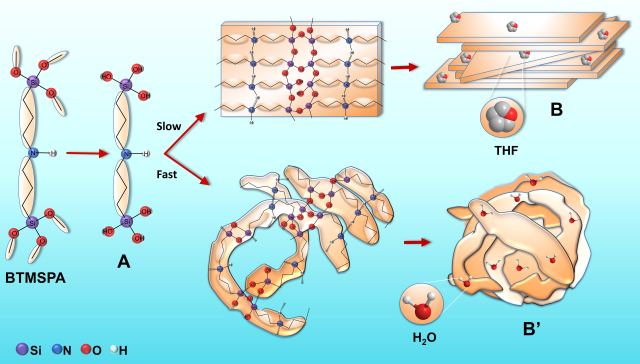Novel Highly Luminescent Amine-Functionalized Bridged Silsesquioxanes
Amine-functionalized bridged silsesquioxanes (BSs) were synthesized from bis[(3-trimethoxysilyl)propyl] amine via a solvent-mediated route. BS-1 and BS-2 were obtained at neutral pH with sub- and stoichiometric amounts of water, respectively, and high tetrahydrofuran content. BS-3 was prepared with hyperstoichiometric water concentration, high tetrahydrofuran content, and hydrochloric acid. BS-4 was synthesized with hyperstoichiometric water concentration, high ethanol content, and sodium hydroxide. BS-1 and BS-2 were produced as transparent films, whereas BS-3 and BS-4 formed white powders. Face-to-face stacking of flat or folded lamellae yielded quasi-hydrophobic platelets with emission quantum yields of 0.05 ± 0.01 (BS-1 and BS-2) or superhydrophilic onion-like nanoparticles with exciting emission quantum yields of 0.38 ± 0.03 (BS-3) and 0.33 ± 0.04 (BS-4), respectively. The latter two values are the largest ever reported for amine-functionalized siloxane-based hybrids lacking aromatic groups. Fast Grotthus proton hopping between =NH+ 2 /=NH groups (BS-3) and =N−/=NH groups (BS-4), promoted by H+ and OH− ions, respectively, and aided by short amine-amine contacts provided by the onion-like morphology, account for this unique optical behavior.
http://dx.doi.org/10.3389/fchem.2017.00131
Autores: Rui F. P. Pereira, Sílvia C. Nunes, Guillaume Toquer, Marita A. Cardoso, Artur J. M. Valente, Marta C. Ferro, Maria M. Silva, Luís D. Carlos, Rute A. S. Ferreira and Verónica de Zea Bermudez
Mechanistic scenario for the synthesis of the BS-1 (top) and BS-4 (bottom) hybrids.
